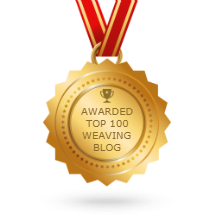|
|
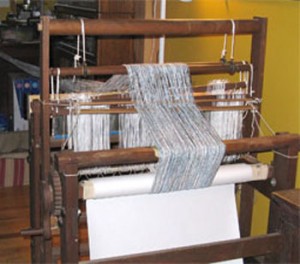 My little loom I have a vintage, handmade floor loom that I love. I knew very little when I bought it, and lucked into this loom that is just right for me.
It does have its limitations, however, as it’s a counterbalance loom. That means that the harnesses really have to be in balance. On my 4-harness loom, that means 2 harnesses up and 2 harnesses down. Pick 2, any 2. But it can’t do unbalanced weaves – those that require 1 harness up and three down (or vice versa).
Therefore, once I figured out how to understand the directions for doing doubleweave, I had to figure out how to do it on my loom. Doubleweave requires 1 harness to be raised at a time, and that’s not in the nature of counterbalance looms.
Now, I know that there are some companies that make counterbalance looms that can be fitted with a shed regulator – a device that makes it possible to get get a clean shed on an unbalanced weave. So I went online and looked at them, trying to figure out what they did and if one would work on my handmade loom. The best I could determine was that it’d require modifications to the loom that I didn’t know how to make, nor was I sure I wanted them made. (Plus they were fairly costly.)
That was the bad news. The good news was that it appeared to me that the primary thing the shed regulator did was to raise up the entire harness. Could I figure out how to do that on my loom?
Well, since I’d already changed all the cords critical to the loom’s operation to Texsolv, it was a simple matter to shorten the top cords and give it a try. It works! YAY!
Now, it’s true that I don’t get a big shed, so when I’m doing doubleweave I have to work slowly, and I have to advance the warp frequently, but it works!
(For you non-weavers, I’m going to put together a post with weaving terminology, and will explain them with photos.)
I’m not suggesting that this would work on every counterbalance loom, but it works on mine. I wouldn’t do unbalanced weaves all the time, but for the baby blankets, it’s ok. It reinforced once again the lovely, little poem that one of the loom’s prior owners taped to it’s main balance.
My simple pleasures,
my gentle joys
weave a lovely pattern
of contentment in my life.
I know you’re all dying to know who won the May contest. Well, I’d love to announce the winner, but I’m waiting for her to respond to my email. So everyone who commented – check your email to see if you got one from me. Perhaps I fell into your spam as an unknown?
I can’t wait to hear from you, and to send off handmade earrings!
Wordplay is fun. The title might make someone (from another planet) think that this post was about babies learning to weave. In fact, it’s about weaving things for babies to use, specifically handwoven baby blankets.
When I first got my lovely floor loom a few years ago, I was a weaving newbie, or baby, if you will. It didn’t take me long to be able to produce a decent scarf in either plain weave or twill, but I wasn’t prepared for anything fancy. I remember reading my weaving bible, Learning To Weave by Deborah Chandler, about doubleweave. I knew for a fact that I didn’t even understand the language she was using, much less have any clue about how to implement her directions. (Doubleweave is a way to weave something that’s twice as wide as your loom. Or you can weave tubes, if you want.)
So I decided to simply ignore that section of the book. Along with several other sections I didn’t understand. Hoping that all in good time, it’d make sense to me. Or that I wouldn’t need or want to do it.
Then suddenly one day about a month ago I was in the shower (a place where I often get inspiration) when I said to myself (ostensibly out of the clear blue – I wasn’t consciously thinking about it), “I bet I can understand those doubleweave directions now.”
Amazingly, I was right – I could understand! So I had to figure out what I needed to make to use the technique while it was hot in my brain. My answer – use up some baby acrylic and make a handwoven baby blanket!
I’d woven a blanket for a friend’s baby about a year earlier, and had to weave it in two strips and stitch them together. Although the friend was really gracious, the baby blanket was less than lovely. Weaving a blankie in one piece would be WONDERFUL!
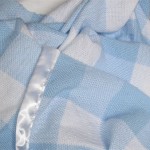 Blue & White Checked Baby Blanket So with several false starts I figured out how to follow the instructions, and wove a checked baby blanket that made me happy. It wasn’t perfect, but it was really quite nice, and I was very satisfied with my first attempt at doubleweave. I put it up on my website, but had no idea if it would sell or not.
Imagine my pleasure when it sold at the first show I brought it to!
Having another show the following weekend, I decided that I’d use the intervening days to weave another baby blanket, this time from a lovely handpainted cotton flannel. I was even happier with the results, and brought it to show #2 of the year. IT SOLD!! I didn’t even get a photo of it before it was gone.
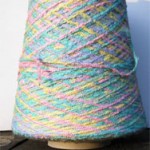 cotton flannel yarn
I figure that I’d best make more handwoven baby blankets. That’s what I’m working on now, turning this lovely little cone of baby-colored cotton flannel yarn into a blanket. Watch for my progress.
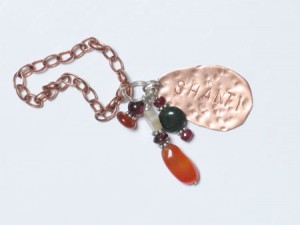 My arthritis talisman Here’s the talisman I made for myself to help ease the chronic aches in my knees.
You can guess that the metal is copper, which has long been recognized as a healing agent for arthritis. I punched the little tab with the word SHANTI, which means peace, hoping that it would bring some peace to my knees. I added the copper chain for two reasons – not only would it provide more of the healing copper, it would give me more options for use of the talisman as a whole. Although I usually carry it in my pocket, if I’m wearing a skirt without pockets, I can easily pin it to my bra by the chain. I actually kind of like this option, as it makes little noises when I move a lot. This gentle sound reminds me that it’s there and makes me smile. The talisman never jangles in my pocket.
I purposely made the entire healing talisman small and lightweight. Knowing that I intended to carry it in my pocket, I wanted something that wouldn’t wear out the fabric quickly, and that wouldn’t be obvious to others that I was carrying it. Now that I’ve been using it for a week, I might rather that it was a bit larger and reminded me that it was there. If this feeling continues for a few weeks, I’ll modify it.
The healing gemstones I used in this in this talisman include carnelian, bloodstone, garnet, mother of pearl, and rubies. Yep, really rubies. I consider myself fortunate to have some sweet little faceted rubies left over from making a piece of custom jewelry for one of my customers a few years ago.
After deciding on the copper, the first gemstone I chose was carnelian. And I knew that I wanted to use more carnelian than any of the other healing gemstones I’d use. Why? Carnelian is a strong gemstone to use for arthritis. If you look closely at the picture, you might notice that the largest piece of carnelian is a bit oddly-shaped, not an absolute oblong. I chose this stone specifically for my talisman. Not only did I like its less-than-perfect shape, my thinking was, and is, that the more “raw” the gemstone, the less it has been “worked” by machines to form it, the closer it is to its natural state and the more healing power it contains. I don’t really know this to be true, but this particular stone spoke to me, so I’m going with it. There’s another small carnelian rondelle on the smallest dangle of the talisman.
Above the carnelian oblong is a small garnet rondelle. Garnet is a gemstone that helps heal inflammation, and arthritis is a chronic form of inflammation. Again, I purposely chose an oddly-shaped stone.
Highest on that dangle is a mother of pearl star. Like carnelian, mother of pearl is recognized as an aid to heal arthritis. Now you might think that I showed quite the contradiction, purposely choosing a less-than-perfect carnelian and garnet, and then picking a highly-worked star for my mother of pearl component. This little off-white star encourages me to shoot for the stars in my healing, to work toward complete cessation of pain and inflammation. It also just makes me smile, and smiling is always a good thing.
The second dangle has two of those lovely little faceted rubies bordering a bloodstone lentil. Rubies are good gemstones for healing arthritis, and bloodstone is good for inflammation.
Finally, the shortest component has the carnelian rondelle I mentioned before and another garnet.
I’ve only been carrying the talisman for about a week, and I have been successful at remembering to transfer it from pocket to pocket each day. Although I’ve been thinking about it, I haven’t yet worn it to bed.
So have I noticed a difference? I can’t say I’ve noticed that my knees hurt less, but I can tell you for sure that when I hear or feel the talisman it makes me smile and feel better mentally. And feeling better mentally is an important part of physical healing. Besides, talismans aren’t magic bullets; it takes time for the gemstones to impart their healing powers.
I will periodically let you know how my knees are doing, but I’m heading outside now to work in my garden!
I have bad knees.
They often ache, don’t like standing for long periods, often refuse to bend tightly, and on occasion complain loudly about kneeling. Why?
In reality, it’s because my knees are as old as I am, and they have carried too much weight most of their lives. I also think there’s some genetic predisposition going on here, as both sisters have similar issues.
However, I find it more satisfying to blame the nuns at my high school. Like most Catholic high schools of the era, we had to wear uniforms, consisting of white blouses, blazers, pleated skirts, knee socks, and saddle shoes (in a unique design of navy blue & grey). I distinctly remember waiting for the bus after school in the middle of a western New York winter. Between the bottom of the rolled-up skirt and the top of the knee socks, my knees were a bright red. When the wind blew, the wool skirt hitting my knees felt like knives slicing against them. This couldn’t have been good, and couldn’t have done my joints any favors. (Ooohhhhh, perhaps my sisters did the same thing and it’s the nuns’ fault that we ALL have bad knees, as opposed to my parents’ genes!)
Regardless of the cause I believe I have some wear/use issues to the cartilage in my left knee and arthritis in both knees. I try to take care of them by daily walking, regular yoga, and routine applications of a wonderful product called Flower Power For Pain made by my herbalist friend, Anne Romance, of Green Heron Gardens. (Anne doesn’t have a website, but you can read a little bit about her here – scroll down to near the bottom of the page for her mini-bio.)
Then the other day I had a big DUH moment. Like a “physician, heal thyself†sort of thing, although I’m no doctor, nor do I play one on TV. But why, oh, why hadn’t I made myself a talisman to help my aching knees?
So I did my research and made one. I’ve just started carrying it. Check back in a few days and I’ll tell you all about my new talisman. I’ll also give you some periodic updates about how my knees feel now that I’m using it.
|
|





